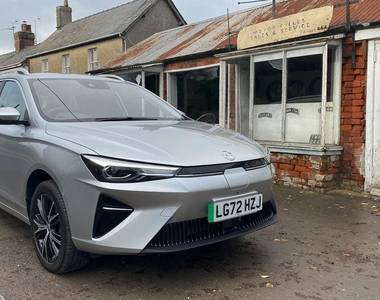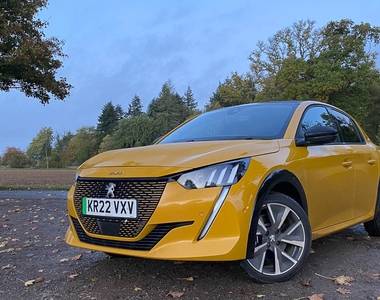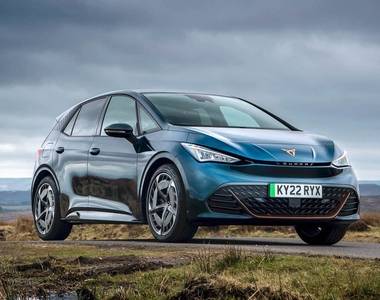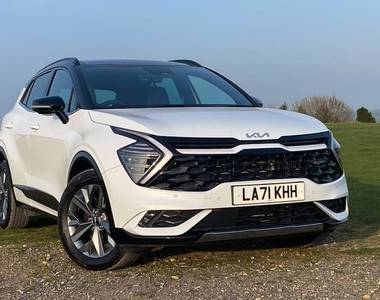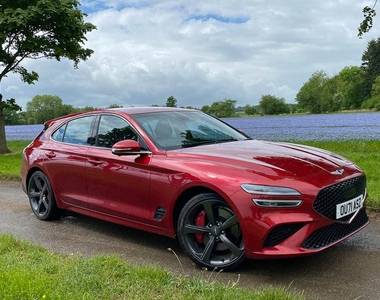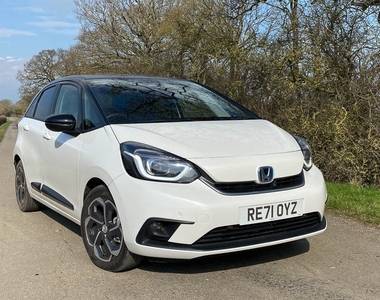The Car.co.uk verdict:
3.92021 will go down as the year Volkswagen discovered its new ‘IDentity'. It launched the ID 3 we’re reviewing here and the ID 4 has not only just hit UK showrooms but it’s also been awarded World Car of the Year 2021. VW will follow this up with the ID 5 later this year along with a performance version of the ID 4.
For those that don’t know and think that VW only makes Polos and Golfs, not to mention cars with diesel engines, the German automaker’s ID models are its all-electric cars - clean, green and in performance versions, a little bit mean, we hope. VW has joined the electric revolution and it’s launched a veritable onslaught of models and marketing. The Voltswagens are coming, but is the ID 3 the new Golf?
Written by Mark Smyth
Pros
- Great entry into electric cars
- Great entry into electric cars
- Very spacious and well equipped interior
Cons
- More expensive than an equivalent Golf
- Confusing model and options choices
- Annoying lane-keeping system
At a glance
- Looks
- Practicality
- Interior
- Equipment and options
- Engine and power
- The drive
- Safety
- Reliability
- Cost
- Why buy
Looks
3.5 out of 5
Design that takes the safe route
In the early days of green cars, many examples looked a little odd. Just think of the Honda Insight and Toyota Prius. They were statement cars, models that were taken seriously by environmentalists and laughed at by everyone else. However, they were ahead of their time and today electric cars are set to dominate the market in the decades ahead. Some look like regular cars, others look slightly different. The ID 3 looks somewhere in the middle and that could appeal to those who are not sure which way to go right now.
As VW’s first mainstream EV it is a big statement car for the German automaker. It stands out from the crowd of Golfs with styling that you will either love or hate. It’s a little dumpy, perhaps made worse by the polished grey primer colour of our test car, but there’s familiarity to it too, with a simple hatchback design that isn’t too far out there.
The same is true inside, where there’s nothing garish, no science fiction design elements
Practicality
3 out of 5
Continues the legacy of practicality for VW
Practicality takes on a new meaning with an EV, because it becomes about how practical it is to live with when it comes to range and charging, at least in these early days. VW claims a range of 263 miles for the ID 3 Life Pro Performance but in spite of a full charge, we could only get it to show just shy of 200 miles. VW says the 58kWh battery can charge to a 260 mile range in just 30 minutes on a 100kW DC charger. We used a 50kW and it took just over an hour which makes sense. Public chargers can be a bit hit and miss, but let’s be honest, most people will plug it in overnight at home and rarely do 200 miles in a day. We’re all getting used to this EV thing.
The range was very accurate though, which is more impressive than you might think. We’ve only seen one other car with such accurate range and that was the Honda e. Generally, as with a petrol or diesel car, the claimed range is rarely attainable but it’s a situation that’s worse in an EV, especially if you drive on the motorway.
Charging aside, the ID 3 is as compact as a Golf, making it easy to live with. It has a decent size boot with seats that fold for larger loads and all the modern stuff we are now used to. In most respects, the ID 3 is as practical as any other VW.
Interior
4 out of 5
So spacious you’ll think you’re in a limo
The interior is remarkably spacious and airy with ample space for five, partly because its 2765mm wheelbase is 145mm longer than the Golf’s despite the ID 3 being just 3mm longer. There’s space for the front passenger to stretch their legs and still leave enough room for the back seat passengers to do the same. We’d even go so far as to compare the rear space to that in a Skoda Superb or even a BMW 7 Series. It’s very spacious indeed.
It’s also nicely designed with details that don’t shout that this car is a bit different. It’s all reasonably familiar with a quality feel to all the materials and some contrast in the type of plastics used. Even the ambient lighting is subtle, with only the light across the dashboard that responds to navigation instructions among other things that could vaguely be called gimmicky, although we quite liked it.
You get all the usual essentials too such as cup holders, storage spots, electric windows and a touchscreen infotainment system as well as a wireless charging pad for your phone in the console between the front seats. There are also USB ports for those sitting in the back.
Boot space is good too with more than enough space to cope with the weekly shop, luggage for a trip away or the kids sports kit.
Equipment and options
4 out of 5
Something for everyone once you figure out the choices available
The list of standard equipment is good, including a 32-amp cable for charging at home with a three-pin plug and a 7.2kW cable for plugging into a home or public charger. There’s also a useful We Connect ID smartphone app that allows you to check on your car.
Infotainment is courtesy of a 5.3-inch touchscreen with navigation, Bluetooth, audio streaming, Apple CarPlay and Android Auto and access to charging information, power usage and vehicle settings. There are plenty of remote controls on the heated steering wheel and an easy to read digital instrument display with the ability to change how it looks. Parking sensors front and rear make parking easy and it has LED headlights and 18-inch wheels.
Options are a bit more complex. There are a number of packs including the Style Pack, Protection Pack and the Travel Pack which hides a clever slide-out bicycle carrier in the rear bumper. Then you can choose everything from paint and alloy wheels to upholstery, decals and more to make it feel a bit more you.
Engine and power
3.5 out of 5More composed than some of its EV rivals
Engine, what engine? We might need to find another title for this section. Let’s call it powertrain or go old school and call it motor, that might cover everything, including hydrogen fuel cell cars. Perhaps we should have a poll. Sorry, thinking out loud. Back to the….motor. The ID 3 is available with a 45, 58 or 77kWh battery pack providing power of 148 bhp in the 48kWh Pure Performance, 143 bhp in the 58kWh Pro, and 201 bhp in the 58kWh Pro Performance and 77kWh Pro S. We tested the 58kWh Pro Performance that produces 201 bhp and 310 Nm. It’ll nip to 62 mph in 7.3 seconds and go on to a top speed of 99 mph. That’s way off the numbers for the Tesla Model 3 but the ID 3 isn’t chasing headline numbers here, it’s about building a reputation for quality and reliability, just as VW did with the Golf and probably the Beetle before that
The drive
4 out of 5
Predictable and comfortable in town and beyond
The ID 3 doesn’t feel as rapid as some rivals, instead it feels cool, calm and collected, which is good because it means we can say it feels a bit Golf-like in terms of its overall feel, except that it doesn’t make any noise.
The gear selector is mounted on the side of the instrument cluster, which does take some getting used to and even when you do it feels a bit unnatural. Select D and the ID 3 glides away without a fuss, making a subtle UFO noise at low speeds to warn pedestrians of its presence. The steering is good and the car well balanced and the engineers have done an excellent job of keeping the outside noises where they belong, outside. It’s very quiet, allowing you to enjoy those fine tunes you’re streaming through the infotainment system.
We did find the wheels thumped over certain surfaces as though the car was fitted with space saver wheels on occasion, but given the recent report on the state of UK roads, it could be the roads as much as the car. Also, the lane keeping system kept telling us to stay in the centre of the lane as though it thought we should be able to measure how many inches it was to the lines on either side.
Generally the ride was superb, comfortably transporting the family around without fuss and safe in the knowledge that the predicted range was accurate, after all, who wants range anxiety right?
Safety
5 out of 5Safety you can rely on
Safety is excellent and the ID 3 received a maximum five stars from vehicle safety organisation Euro NCAP. That’s not surprising as standard safety equipment includes a full suite of airbags, Driver Alert system, fatigue detection, electronic stability control. autonomous emergency braking, pedestrian protection and more, basically every acronym you can think of. It also has Adaptive Cruise Control to manage your speed and distance to the vehicle in front which is great if you’re on the motorway commute.
Reliability
4 out of 5Carries forward VW’s reputation for reliability
One of the great things about an EV is they have fewer parts than a car with an internal combustion engine. That’s bad news for mechanics who like to fix stuff and give us an invoice, but good news for owners as there’s less that needs fixing. There’s a standard three-year/60,000 mile warranty with an eight-year/100,000 mile warranty on the batteries.
It’s very new so it’s difficult to know just how reliable it is, but Volkswagen generally has a good reputation in this department and we expect it to be the same with its new line of EVs.
Cost
4 out of 5Affordable entry into the future of electric vehicles
The ID 3 Life Pro Performance retails at £32,990 which falls well within the government’s cap of £35,000 to qualify for a purchasing grant. That means you get £2,500 off the price making it £30,490. It’s still more than an equivalent Golf but not only are you switching to cleaner transport, you should reduce your running costs too. Charging at home is generally the cheapest option as the cost to use a public charger can vary. To give you an idea, we charged at a Revive 50kW charger near Bristol and it cost £13.06 to get from 26% battery to full, that/s about £0.30/kWh.
Pricing for the range before the grant starts at £30,870 for the ID 3 City rising to £42,600 for the ID 3 Tour with a further nine models in-between to cater to everyone from company car drivers to tech-hungry buyers.
Why buy
4 out of 5Great way to plug in to the electric car future
Buy it because it’s clean and green and it’s an electric Volkswagen and everyone’s buying electric. You want a proper reason? Oh alright then, it’s a great hatchback that’s easy to live with, spacious and efficient. But hang on, because we’ve been told that the ID 4 crossover is better - better to look at, better to drive and better value for money plus it’s the World Car of the Year. So should you buy that instead? We haven’t driven it so unfortunately can’t tell you for certain, but we liked the ID 3 with its massive interior space and refusal to be full of gimmicks like farting noises and flashy lights. It’s not going to be the new Golf or Beetle, but it’s an excellent start for VW in the electric car space.











